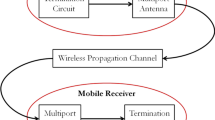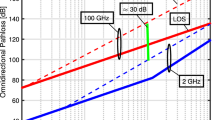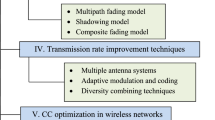Abstract
In this paper, we present a design of two-way communication system with relay selection in two-way cooperative system over cascaded Nakagami-\(m\) fading channels. In the proposed scheme, in which all terminals are in motion as mobiles or vehicles, two users first broadcast their information to relays. Then, a single relay with a minimum sum symbol error rate (SER) will be selected to broadcast the received signals back to the sources. In other words, in the selection process, we investigate a simple suboptimal min-max criterion for relay selection, where a single relay that minimizes the maximum SER of two source nodes will be selected. Specifically, we have derived expressions of cumulative distribution function and moment generating function of end-to-end signal-to-noise ratio. By using these expressions, we have analyzed the performance of considered system in terms of outage probability and SER expression. Numerical and simulation results show the validity of the proposed mathematical analysis and point out the confirmation of the analytical results.







Similar content being viewed by others
References
Laneman, J. N., Tse, D., & Wornell, G. (2004). Cooperative diversity in wireless networks: Efficient protocols and outage behaviour. IEEE Transactions on Information Theory, 50, 3062–3080.
Nabar, R. U., Bölcskei, H., & Kneubuhler, F. W. (2004). Fading relay channels: Performance limits and space-time signal design. IEEE Journal of Selected Areas in Communications, 22, 1099–1109.
Abualhaol, I. Y., & Matalgah, M. M. (2011). Performance analysis of cooperative multi-carrier relay-based UAV networks over generalized fading channels. International Journal of Communication Systems, 24, 1049–1064.
Xiangdong, J., Haiyang, F., Longxiang, Y., & Laiqiang, Z. (2011). Superposition coding cooperative relaying communications: Outage performance analysis. International Journal of Communication Systems, 24, 384–397.
Rankov, B., & Wittneben, A. (2007). Spectral efficient protocols for half-duplex fading channels. IEEE Journal of Selected Areas in Communications, 25, 379–389.
Madsen, A., & Zhang, J. (2005). Capacity bounds and power allocation for wireless relay channels. IEEE Transactions on Information Theory, 51, 2020–2040.
Ahlswede, R., Cai, N., Li, S., & Yeung, R. W. (2000). Network information flow. IEEE Transactions on Information Theory, 46, 1204–1216.
Suraweera, H. A., Louie, R. H. Y., Li, Y. H., Karagiannidis, G. K., & Vucetic, B. (2009). Two hop amplify-and-forward transmission in mixed Rayleigh and Rician fading channels. IEEE Communications Letters, 13, 227–229.
Lei, X., Fan, P., Fan, L., Wong, K. K., Larsson, E. G., & Duong, T. Q. (2011). Closed-form performance analysis of multihop amplify-and-forward transmission in Nakagami-\(m\) fading channels. IEEE Signal Processing Letters, 18, 454–457.
Han, Y., Ting, S. H., Ho, C. K., & Chin, V. H. (2009). Performance bounds for two-way amplify-and-forward relaying. IEEE Transactions on Wireless Communications, 8, 432–439.
Ping, J., & Ting, H. S. (2009). Rate performance of AF two-way relaying in low SNR region. IEEE Communications Letters, 13, 233–235.
Bahrami, H. R., & Tho, L. N. (2011). Distributed BLAST with relay selection for multi-antenna AF relaying. International Journal of Communication Systems, 24, 473–482.
Zhang, X., & Gong, Y. (2009). Adaptive power allocation in two-way amplify-and-forward relay networks. In Proceedings of IEEE ICC. Dresden, Germany.
Nguyen, H. X., Nguyen, H. H., & Le-Ngoc, T. (2010) Diversity analysis of relay selection schemes for two-way wireless relay networks. [Online]. http://www.springerlink.com/content/u1x45421r7764x33/.
Jing, Y. (2009). A relay selection scheme for two-way amplify-and-forward relay networks. In Proceedings of international conference wireless communicatrion signal processing (pp. 1–5).
Atapattu, S., Jing, Y., Jiang, H., & Tellambura, C. (2013). Relay selection schemes and performance analysis approximations for two-way networks. IEEE Transactions on Communications, 61, 987–998.
Li, Y., Louie, R. H. Y., & Vucetic, B. (2010). Relay selection with network coding in two-way relay channels. IEEE Transactions on Vehicular Technology, 59, 4489–4499.
Song, L. (2011). Relay selection for two-way relaying with amplify-and-forward protocols. IEEE Transactions on Vehicular Technology, 60, 1954–1959.
Kovacs, I. Z. (2002). Radio channel characterization for private mobile radio systems: Mobile-to-mobile radio link investigations. Ph.D. Thesis. Aalborg University.
Andersen, J. B. (2002). Statistical distributions in mobile communications using multiple scattering. In URSI general assembly proceedings, session CBF.
Salo, J., El-Sallabi, H., & Vainikainen, P. (2006). Statistical analysis of the multiple scattering radio channel. IEEE Transactions on Antennas Propagation, 54, 3114–3124.
Salo, J., El-Sallabi, H., & Vainikainen, P. (2006). The distribution of the product of independent Rayleigh random variables. IEEE Transactions on Antennas Propagation, 54, 639–643.
Erceg, V., Fortune, S. J., Ling, J., Rustako, A., & Valenzuela, R. (1997). Comparisons of computer-based propagation prediction tool with experimental data collected in urban microcellular environments. IEEE Journal on Selected Areas in Communications, 15, 677–684.
Uysal, M. (2005). Maximum achievable diversity order for cascaded Rayleigh fading channels. IET Electronics Letters, 41, 1289–1290.
Ilhan, H., Uysal, M., & Altunbas, I. (2009). Cooperative diversity for inter-vehicular communication: performance analysis and optimization. IEEE Transactions on Vehicular Technology, 58(7), 3301–3310.
Ilhan, H., Altunbas, I., & Uysal, M. (2010). Novel distributed space-time trellis codes for relay systems over cascaded Rayleigh fading. IEEE Communications Letters, 14, 1140–1142.
Talha, B., & Patzold, M. (2011). Channel models for mobile-to-mobile cooperative communication systems: A state of the art review. IEEE Transactions on Vehicular Technology Magazine, 6, 33–43.
Sepukre, M., Gozalves, J., Harri, J., & Hartenstein, H. (2011). Contextual communications congestion control for cooperative vehicular networks. IEEE Transactions on Wireless Communications, 10, 385–389.
Seyfi, M., Muhaidat, S., Liang, J., & Uysal, M. (2011). Relay selection in dual-hop vehicular networks. IEEE Signal Processing Letters, 18, 134–137.
Karagiannidis, G. K., Sagias, N. C., & Mathiopoulos, P. T. (2007). N*Nakagami: A novel stochastic model for cascaded fading channels. IEEE Transactions on Communications, 55, 1453–1458.
Sagias, N. C., & Tombras, G. S. (2007). On the cascaded Weibull fading channel model. Journal of The Franklin Institute, 344, 1–11.
Trigui, I., Laourine, A., Affes, S., & Stephenne, A. (2009). On the performance of cascaded generalized K fading channels. In IEEE GLOBECOM (pp. 1–5).
Ilhan, H. (2012). Performance analysis of two-way AF relaying systems over cascaded Nakagami-\(m\) fading channels. IEEE Signal Processing Letters, 19, 332–335.
Gradshteyn, I. S., & Ryzhik, M. I. (2007). Table of integrals, series and products (7th ed.). London: Academic Press.
Simon, M. K., & Alouini, M. S. (2005). Digital communication over fading channels (2nd ed.). Hoboken, NJ: Wiley.
Hasna, M. O., & Alouini, M. S. (2004). Harmonic mean and end-to-end performance of transmission systems with relays. IEEE Transactions on Communications, 52, 130–135.
Adamchik, V. S., & Marichov, O. I. (1990). The algorithm for calculating integrals of hypergeometric type functions and its realizations in REDUCE system. In Proceedings of the international conference on symbolic and algebraic computation. Tokyo, Japan.
http://functions.wolfram.com/HypergeometricFunctions/MeijerG/.
David, H. A. (1970). Order statistics. Hoboken, NJ: Wiley.
McKay, M. R., Grant, A. J., & Collings, I. B. (2007). Performance analysis of MIMO-MRC in double-correlated Rayleigh environments. IEEE Transactions on Communications, 55, 497–507.
Author information
Authors and Affiliations
Corresponding author
Additional information
The work of Haci Ilhan was supported by the Scientific and Technological Research Council of Turkey under Project 113E229.
Rights and permissions
About this article
Cite this article
Ilhan, H. Relay Selection in Two-Way Cooperative Systems. Wireless Pers Commun 77, 1329–1341 (2014). https://doi.org/10.1007/s11277-013-1583-0
Published:
Issue Date:
DOI: https://doi.org/10.1007/s11277-013-1583-0




